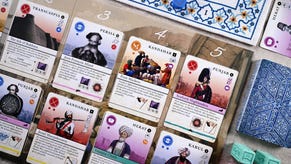In being both profound and playable, Pax Pamir 2E became one of the most important board games of 2019
Gaming the Great Game.
Spend long enough in this hobby and you’re bound to encounter a particular misconception. You may have heard it already: either a board game can say something profound or it can be, well, a good game. Message or playability. Statement or enjoyment. Never both.
Of course, the entire notion is bupkis. And nothing brings the theory tumbling down than a glimpse at this year’s second edition of Pax Pamir, the latest title from Root designer Cole Wehrle.
Pax Pamir’s 19th-century Afghanistan is a region plagued by intrusive powers: the expanding Russian frontier in one direction, the British buffer state to India in the other and the tatters of the Durrani Dynasty squabbling in the middle. Colonialism isn’t exactly the freshest setting - some might argue it kicked off the modern hobby when Catan’s robbers were displaced by expanding cities and longest road bonuses - but Pax Pamir 2E doesn’t cast you as a foreign aggressor. Instead, you’re a middleman in The Great Game between warring empires, a tribal chieftain looking to secure a place for their people amidst the turbulence of conflict. You’re the occupied, not the occupier.
Unlike other post-colonial fantasies such as Spirit Island, Wehrle’s vision is weathered by historical pragmatism. There are no noble last stands to make, no magical spirits to invoke for aid, no defiant bellows spat in the faces of your unwanted overlords. Instead, survival is the name of the game, and you survive by going along. By picking a side and guiding their armies, informing to their spies, and protecting their trade roads. And then, in all likelihood, by betraying them at the last moment in order to support whichever side is winning the war. The tree that bends with the wind that stays rooted, after all.
Sounds lofty, right? The wild thing is that Wehrle actually pulls it off, presenting a game that’s both playable and evocative.
From the very beginning you’re presented with two main focal points: a cloud-level view of Afghanistan and a marketplace for purchasing cards. In most games the map is where the action is found; here, the market is easily the more important consideration. You initially have access to only two actions, and both are reliant on the market. Even the map is static on its own. It’s only as you purchase and play cards that columns of soldiers, tribal discs for controlling local politics, and maybe the occasional spy emerge onto the table in dribs and drabs, each placement meaningful but not likely to overwhelm you with new information.
Pax Pamir 2E is refreshingly easy to play, but also asks hard questions.
Even better, cards trickle out information of their own in the form of new actions. Armies can march along roads, but not until you’ve secured a card that provides the corresponding action. The same goes for everything else, from taxation to assassination. This is a boon when teaching the game, making it possible to explain options as they appear rather than front-loading every detail. Later, this lends each play its own feel. Sometimes armies will trample from one end of the map to the other, other times local chieftains will jealously destroy any roads leading into their lands. Sometimes you’ll become embroiled in years-long economic stalemates, or spend your time engaged in invisible wars of espionage.
If that sounds intimidating, welcome to Phil Eklund’s Pax series, which has always had a reputation for being difficult to learn. Some of that is thanks to how deeply the series digs into its subject matter. Its first entry, Pax Porfiriana, depicts competing landowners striving to inherit President Porfirio Diaz’s Mexico through coup, communism or just plain brown-nosing. Pax Renaissance investigates what ultimately propelled Europe into the modern age, and presents equal arguments for everything from imperial politics to the funding of banking houses. Even Pax Emancipation’s global struggle to end slavery is anything but simple, prying into the competing motivations of its various actors. As a series, Pax has always cast a wide net, simulating difficult and even contradictory factors within the same game.
The original edition of Wehrle’s Pax Pamir was the second entry in the Pax series, and quickly garnered a reputation of its own - namely, that in addition to being uncommonly clever, its victory conditions were also notoriously difficult to understand. For the second edition, Wehrle was determined to streamline the endgame. Although it still demands more attention than your customary tally of victory points, it manages to provide goals that are brain-burny without requiring so much attention that the game feels like a chore. Basically, everything revolves around four dominance cards that have been shuffled into the market deck. When one of these appears, it can be purchased like any other card. But instead of entering your court and offering new units and actions, a dominance check momentarily pauses the game to determine which invading empire has successfully seized control.
This is where it gets a little tricky. If one of the game’s three empires has enough pieces, it wins the current war. Not that the game is over. Any chieftain - remember, that’s you - who has proved themselves most useful to that empire now earns a handful of points. Then everybody packs up and goes home. All those warring armies are removed from the map and the game resumes a few years later as hostilities continue to simmer. Barring total victory, it’s possible that no empire claims the trophy. Then chieftains take advantage of the chaos to earn points based on how much raw control they wield over the countryside. In the first case, victory is evaluated by military and economic strength - and your loyalty to its owner. In the other, power is more ephemeral, based on things like local patronage and healthy spy networks.
Either way, this is where Pax Pamir announces itself as not only an utter delight to play, but also one of the most important games of the year. It’s easiest to think of dominance checks as flashpoints: climactic moments where one empire wins, the others lose and everybody goes home for a while. Emphasis on “for a while”. Because even though an empire has claimed victory, the game isn’t finished. The soldiers return home for a parade and free drinks, but for you V-Day is just another weekday. As a native of a disputed land, this conflict was merely one war in a sequence of them. Your struggle is generational, each clash and feud dovetailing into the next. Some power has been claimed. Now it must be held.
This is what board games are accomplishing in 2019. For a title that simulates economies and armies and everything in between, Pax Pamir 2E is refreshingly easy to play, but also asks hard questions about the impact of colonialism and foreign wars. At its best, when you’re wading through your third campaign and fourth alliance, when friends have become enemies and old rivals have transformed into convenient bedfellows, it even asks for something unexpected: empathy. This is what it means to live in a place that other people fight over. If the game didn’t have the decency to wrap up after four dominance checks, it might continue indefinitely.
All the better that the medicine goes down so sweetly. Rather than droning out a lecture, Cole Wehrle’s Pax Pamir capitalises on every moment to create a play experience that’s as thrilling as it is relevant. If only every history lesson could be so approachable.






